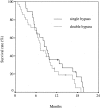The need for a prophylactic gastrojejunostomy for unresectable periampullary cancer: a prospective randomized multicenter trial with special focus on assessment of quality of life
- PMID: 14631226
- PMCID: PMC1356171
- DOI: 10.1097/01.sla.0000098617.21801.95
The need for a prophylactic gastrojejunostomy for unresectable periampullary cancer: a prospective randomized multicenter trial with special focus on assessment of quality of life
Abstract
Objective: To evaluate the effect of a prophylactic gastrojejunostomy on the development of gastric outlet obstruction and quality of life in patients with unresectable periampullary cancer found during explorative laparotomy.
Summary background data: Several studies, including one randomized trial, propagate to perform a prophylactic gastrojejunostomy routinely in patients with periampullary cancer found to be unresectable during laparotomy. Others suggest an increase of postoperative complications. Controversy still exists in general surgical practice if a double bypass should be performed routinely in these patients.
Methods: Between December 1998 and March 2002, patients with a periampullary carcinoma who were found to be unresectable during exploration were randomized to receive a double bypass (hepaticojejunostomy and a retrocolic gastrojejunostomy) or a single bypass (hepaticojejunostomy). Randomization was stratified for center and presence of metastases. Patients with gastrointestinal obstruction and patients treated endoscopically for more than 3 months were excluded. Primary endpoints were development of clinical gastric outlet obstruction and surgical intervention for gastric outlet obstruction. Secondary endpoints were mortality, morbidity, hospital stay, survival, and quality of life, measured prospectively by the EORTC-C30 and Pan26 questionnaires. It was decided to perform an interim analysis after inclusion of 50% of the patients (n = 70).
Results: Five of the 70 patients randomized were lost to follow-up. From the remaining 65 patients, 36 patients underwent a double and 29 a single bypass. There were no differences in patient demographics, preoperative symptoms, and surgical findings between the groups. Clinical symptoms of gastric outlet obstruction were found in 2 of the 36 patients (5.5%) with a double bypass, and in 12 of the 29 patients (41.4%) with a single bypass (P = 0.001). In the double bypass group, one patient (2.8%) and in the single bypass group 6 patients (20.7%) required (re-)gastrojejunostomy during follow-up (P = 0.04). The absolute risk reduction for reoperation in the double bypass group was 18%, and the numbers needed to treat was 6. Postoperative morbidity rates, including delayed gastric emptying, were 31% in the double versus 28% in the single bypass group (P = 0.12). Median postoperative length of stay was 11 days (range 4-76 days) in the double versus 9 days (range 6-20 days) in the single bypass group (P = 0.06); median survival was 7.2 months in the double versus 8.4 months in the single bypass group (P = 0.15). No differences were found in the quality of life between both groups. After surgery most quality of life scores deteriorated temporarily and were restored to their baseline score (t = -1) within 4 months.
Conclusions: Prophylactic gastrojejunostomy significantly decreases the incidence of gastric outlet obstruction without increasing complication rates. There were no differences in quality of life between the two groups. Together with the previous randomized trial from the Hopkins group, this study provides sufficient evidence to state that a double bypass consisting of a hepaticojejunostomy and a prophylactic gastrojejunostomy is preferable to a single bypass consisting of only a hepaticojejunostomy in patients undergoing surgical palliation for unresectable periampullary carcinoma. Therefore, the trial was stopped earlier than planned.
Figures



Comment in
-
Addition of prophylactic gastrojejunostomy to hepaticojejunostomy significantly reduces gastric outlet obstruction in people with unresectable periampullary cancer.Cancer Treat Rev. 2004 Jun;30(4):389-93. doi: 10.1016/j.ctrv.2004.03.001. Cancer Treat Rev. 2004. PMID: 15145513 No abstract available.
References
-
- Warshaw AL, Gu ZY, Wittenberg J, et al. Preoperative staging and assessment of resectability of pancreatic cancer. Arch Surg. 1990;125:230–233. - PubMed
-
- Sohn TA, Lillemoe KD, Cameron JL, et al. Surgical palliation of unresectable periampullary adenocarcinoma in the 1990s. J Am Coll Surg. 1999;188:658–666; discussion 666–669. - PubMed
-
- van Heek NT, van Geenen RC, Busch OR, et al. Palliative treatment in “peri”-pancreatic carcinoma: stenting or surgical therapy? Acta Gastroenterol Belg. 2002;65:171–175. - PubMed
-
- Russell RC. Palliation of pain and jaundice: an overview. Ann Oncol. 1999;10(suppl 4):165–169. - PubMed
Publication types
MeSH terms
LinkOut - more resources
Full Text Sources

